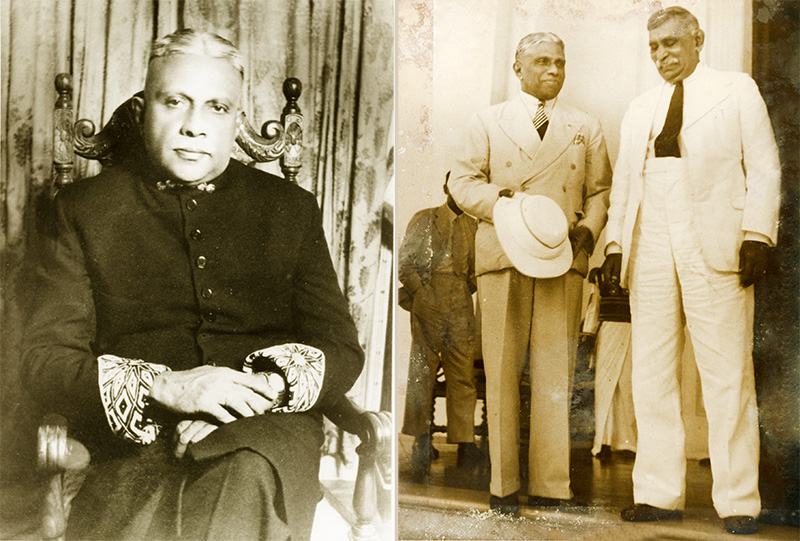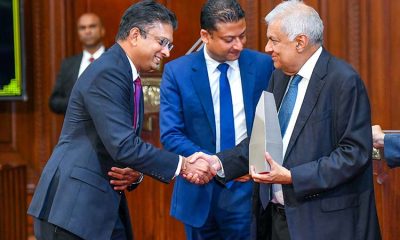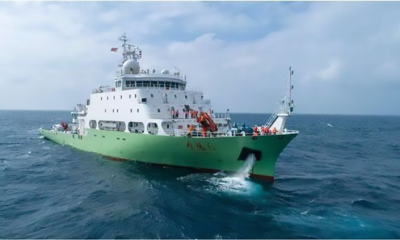Opinion
Throw more light on green foods

Recently, a friend of mine had to see a doctor for a certain skin condition and a full blood report was ordered. It was discovered that his platelet count was dangerously low.
He consulted an eminent physician with the said blood report. Having eliminated dengue, he was subjected to a series of tests, and was told that there was nothing wrong with him. All vital organs were behaving well. During the conversation with the doctor my friend had said that he consumed kathurumurunga about thrice a week. The doctor warned him to stop it forthwith, and added that murunga leaves were even worse.
Kathurumurunga is a popular cheap vegetable in Sri Lanka, which grows along hedges. By the way, it is no longer cheap, costing Rs. 80 for a small bundle. It is preferred over the other greens, because it is not contaminated with soil and flood waters etc. There have been many write-ups in literature praising the benefits of murunga leaves. Many people believe that the more greens you consume it is better for you nutritionally. Now to find it is not so.This reminds me of a story heard as a kid.
There had been a team of Rishis in ancient India listing out what to eat and what not to. Somebody suggests for example bandakka, and a protest erupts because it is bad for some thing or the other. Then comes brinjals; no way, it is bad for some other thing. All the veggies suffered the same fate till it came to plain water. A rishi said too much of it too was bad. So, water too was stricken off.
Perhaps, the lesson to learn is, yes but in moderation.Can somebody throw some light on this kathurumurunga fiasco?
GAMINI PEIRIS Panadura
Opinion
May Day: An election is approaching

An election is approaching and all the political parties are ready to hammer and tongs at one another. Each promising the never-ending promises made over the years.
All the trade unions will be split up and taken under the wing of each party to make sure they shout the loudest.
Thus trade unions are robbed of a day to celebrate their rights. And: In all this mayhem, no politician remembers to pay tribute to the man who gave the workers their rights.
May Day was not created by A.E. Goonesinha for political rallies and marches. It was created to celebrate the worker. So, at least before all the madness starts, a tribute to this gentleman of decency and honesty should be priority.
The father of the Labour movement and trade unions in Ceylon – the former Minister of state and mayor of Colombo – A.E. Goonesinha!
Alexander Ekanayake Goonesinha was a gentleman who rose against the British hierarchy to free the worker and give him dignity and rights.
It was not an easy task at the time. There were Sri Lankans who fraternised with the British to win favours and who denounced and agitated against men who fought for the rights of the workers.
Days were spent in prison for the cause. Finally it proved successful and A.E. Goonesinha represented Ceylon at the British Empire Labour Conference in London in 1928 – to register May 1st as the worker’s day in Sri Lanka which was first held in 1927 under the leadership of A.E. Goonesinha.
He was also responsible for obtaining Universal Adult Suffrage from the Donoughmore Commission in 1928. Sri Lankan workers and the general public, regardless of income or eduation, were given the right to vote – including women’s franchise which is hardly ever mentioned today.
A.E. Goonesinha was one of the key persons in the struggle for independence. He was never one to mince his words. He was forthright and outspoken and worked only for the worker’s betterment in society. He later went as ambassador to Indonesia and Burma.
He was aksed by SWRD to join his party for the 1956 election, but A.E. Goonesinha did not agree with his policies and contested for his labour party. Today’s politicians jump from party to party according to their own private agendas. It’s a case of make hay while the sun shines and let the country go to the dogs.
Strength, determination, dedication, bravour and courage and above all integrity: A.E. Goonesinha was born on 1st May 1891 in Kandy. A symbolic sign that one day he would make May 1st a day of dignity and respect for the labourer.
Today’s May Day rallies have nothing to do with respecting the labourer. The labourer is used for shouting slogans and for walking behind politicians who want to swell crowds and show their power.
It is hoped that political parties and leaders will forget party politics and unite to work together for the mutual welfare and benefit of Sri Lanka.
Yasmin Koch
Opinion
‘Ethir: Legendary high jumper’ – a response

by Thiagaraja Arasanayagam
I read with great interest the article, ‘Ethir: Legendary high jumper,’ in The Island newspaper of 22 April, 2024, not only for the information but the personal reaction I experienced when memories of the past came flowing back, memories of a young student at St Joseph’s College being trained at the jumping pit, and I, also a student, watching fascinated by the slim, tall figure sailing over the bar, and my English teacher, famous at this time as an Athletics coach putting this young fellow through his paces. I asked my teacher, “Sir, who is this fellow …?”
My teacher replied, ” Oh, this chap is from Jaffna. He has come here to be trained by me.”
Mr Anthony Abeysinghe taught me English in the Junior form and may have kindled my love for English literature and my aspiration to be a tenor in the future with his sudden outburst of an aria in the midst of an English class.
Mr Abeysinghe was the most wanted man especially as a coach. I remember many a contemporary of mine at St. Joseph’s College being referred to as “imported” athletes. Some of those who were trained by Mr Abeysinghe won Gold at the Public schools meet in Colombo. They included Ephron Fernandi ( sprinter), the Amarasekera Brothers from St Anne’s Kurunegala, (sprinters) and Felix Samarawickreme, who hailed from Kandy and established a new record of 61.8 seconds in the 440 yards.
So, it was this article which took me back in time. Ethir was in the Science block cut away from us Arts students. The day I encountered my English teacher training this hearty lad, I was happy to see yet another student deep in sports and studies.
This article was also very close to my heart because I was also born in 1934 in a remote village of Navaly and having spent the war years in that village. We never wore shoes in Navaly and all our athletes were unaware of what at St Joseph’s referred to as “spikes”. I remember telling my English teacher “Sir, we never wore shoes in Jaffna,” when he stood by the pit and muttered, “Time we get this fellow a pair.”
I studied in a school in the adjacent village of Manipay, when I was seven years old. My brothers and I had a tall, lanky fellow as a friend who lived next to our house. He was a high jumper who won the Jaffna schools circuit meet title. He went to Colombo for the Public schools meet where he was uncomfortable as he wore no spikes, while all the other competitors were well equipped. All the other students at the Public schools meet wore pants and colourful blazers, carrying the school flag held aloft proudly.
It was time for the parade of the Athletic teams of all the schools. The announcer kept calling the teams to assemble for the parade and so they were all there except this one man from my village. “Manipay Hindu College, calling team, Manipay Hindu, for the third time. Assemble for the parade.” The young fellow was embarrassed, overwhelmed by the colour and splendour that he pulled out the flag from the pole and thrust it in his pocket as he heard the pleading, “Manipay Hindu where are you?”
The young fellow who wouldn’t join the parade was the young six-footer, Arunakulasingham, the champion high jumper, who despite all the advantages the other athletes had, won the high jump title barefooted and sailing over the bar to the shock of all those well-equipped athletes.
My memory goes back to other incidents which go to show that nothing is beyond achievement. This article speaks of mud houses and Palmyra leaf roofs, they were the most suitable for extreme warm days in Navaly.
The last incident that comes to my mind is when I was a student at St Joseph’s College my mother accosted me as I returned from school saying, ” Don’t go to your room I have given it to someone.”
“Who is this fellow?” I asked my mother.
My mother said that he was a young athlete from Jaffna who had come to participate in the Public schools meet with his school team. He turned out to be the son of Ramasamy, who worked for our family in Navaly.
This article on Ethir evoked very pleasant and nostalgic memories of him as well as my teacher who was his trainer Anthony Abeysinghe. I was so glad to observe him practising high jump. He was a quiet and unassuming boy.
I am thankful to the writers of this article for remembering this outstanding and quiet Josephian who came all the way to Colombo from Jaffna near my village of Navaly to represent the country and to bring fame and recognition to this island.
Opinion
Duty-free vehicle permits for MPs

The Island recently carried a photo of how people were travelling to work in an overcrowded train after celebrating the New Year. People travel in trains clinging on to doors and windows, standing in between carriages and sitting on the roofs of congested trains.
Then on the same page there was a report about MPs being impatient because of the delay in issuing duty-free vehicle permits to them. The MPs have asked for a duty-free vehicle worth Rs 20 million each and said that it is not possible for them to carry out their duties without new vehicles. However, it is an open secret that most of the vehicles of Ministers and MPs are used by their families.
Time was when we had parliamentarians who used public transport and loved mingling with the people, understood their problems and were unassuming. The late Minister Dahanayake travelled by bus from Galle to Colombo. After getting defeated as Prime Minister, he returned home in a bus. Now, defeated politicians leave Temple Trees by helicopter!
Minister Wanninayake travelled from Kurunegala to Colombo by train and Minister M. D. Banda travelled from Polgahawela to Colombo daily by train. There were also others who used public transport and today in some countries like Sweden politicians use public transport or ride bicycles. When Tony Blair was PM, his wife travelled to work by bus or train. But our MPs ride bicycles only to gain media attention when fuel prices increase.
Dr. P. A. Samaraweera
-

 Business5 days ago
Business5 days agoSri Lanka Resorts of Cinnamon Hotels & Resorts mark Earth Day with impactful eco-initiatives
-

 Business6 days ago
Business6 days agoDialog Axiata recognised as the Most Significant FDI Contributor by BOI
-

 Business6 days ago
Business6 days agoUNESCAP Technical Cooperation Highlights Report flags significant strides in its partnership with Sri Lanka
-

 Business7 days ago
Business7 days agoComBank crowned ‘Best Bank in Sri Lanka’ by Global Finance for 22nd year
-

 Business7 days ago
Business7 days agoCinnamon Lakeside Colombo welcomes Nazoomi Azhar as its new General Manager
-

 News4 days ago
News4 days agoGerman research ship allowed Sri Lanka port call after Chinese-protest led clarification
-

 News4 days ago
News4 days agoSri Lankan Oil and Gas exploration grinds to a standstill amid protracted legal battle
-

 Editorial6 days ago
Editorial6 days agoShocks from Bills



























